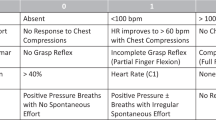Summary
The relation between intra-partum cardiotocography (CTG), cord blood acid-base status, Apgar score and neonatal morbidity was studied in 1228 consecutively live-born babies and in a subgroup of 200 babies (148 babies with a 1 min Apgar score≤8 and 52 randomly selected babies with a 1 min Apgar score≥9). The scores for the individual components of the 1 min Apgar score were strongly associated with each other, whereas the scores for the individual components of the 5 min Apgar score were less strongly associated. At 1 min the scores for muscle tone, reflex irritability and respiration but not the scores for heart rate and skin colour were associated with arterial and venous cord blood pH (low scores being associated with low pH). Out of the individual components of the Apgar score, heart rate and reflex irritability at 1 min were the best discriminators between “healthy or relatively healthy” and “severely ill” babies. Intrapartum CTG, total Apgar score and cord blood acid-base status were only weakly related. Venous cord blood pH was the best predictor of the 1 min Apgar score. Intra-partum CTG (silent pattern), 5 min Apgar score and venous cord blood pH were the best predictors of severe neonatal morbidity.
Similar content being viewed by others
References
Bishop YMM, Fienberg SE, Holland PW (1975) Discrete multivariate analysis: Theory and practice. MIT Press, Cambridge, Mass
Bretscher J, Saling E (1967) pH values in the human fetus during labor. Am J Obstet Gynecol 97: 906–911
Chamberlain G, Banks J (1974) Assessment of the Apgar score. Lancet II: 1225–1228
Crawford JS, Davies P, Pearson JF (1973) Significance of the individual components of the Apgar score. Br J Anaesth 45: 148–158
Dijxhoorn MJ, Visser GHA, Touwen BCL, Huisjes HJ (1987) Apgar score, meconium and acidemia at birth in small-for-gestational age infants born at term, and their relation to neurological morbidity. Br J Obstet Gynaecol 94: 873–879
D'Souza SW, Black P, Cadman J, Richards B (1983) Umbilical venous blood pH: a useful aid in the diagnosis of asphyxia at birth. Arch Dis Child 58: 15–19
Fienberg SE (1977) The analysis of cross-classified categorical data. MTP Press, Cambridge, Mass
Huisjes HJ, Aarnoudse JG (1979) Arterial or venous umbilical pH as a measure of neonatal morbidity? Early Hum Dev 3: 155–161
Josten BE, Johnson TRB, Nelson JP (1987) Umbilical cord blood pH and Apgar scores as an index of neonatal health. Am J Obstet Gynecol 157: 843–848
Lagerkrantz H (1982) Letter. Lancet I: 966
Lievaart M, de Jong PA (1984) Acid-base equilibrium in umbilical cord blood and time of cord clamping. Obstet Gynecol 63: 44–47
Low JA, Galbraith RS, Muir DW, Killen HL, Pater EA, Karchmar EJ (1983) Intrapartum fetal hypoxia: a study of long-term morbidity. Am J Obstet Gynecol 145: 129–134
Low JA, Galbraith RS, Muir DW, Killen HL, Pater EA, Karchmar EJ (1985) The relationship between perinatal hypoxia and newborn encephalopathy. Am J Obstet Gynecol 152: 256–260
Low JA (1988) The role of blood gas and acid base assessment in the diagnosis of intrapartum fetal asphyxia. Am J Obstet Gynecol 159: 1235–1240
Luthy DA, Shy KK, Strickland D, Wilson J, Bennett FC, Brown ZA, Benedetti TJ (1987) Status of infants at birth and risk for adverse neonatal events and long-term sequele: a study in low birth weight infants. Am J Obstet Gynecol 157: 676–679
Ruth VJ, Raivio KO (1988) Perinatal brain damage: predictive value of metabolic acidosis and the Apgar score. BMJ 297: 24–27
Steer PJ, Eigbe F, Lissauer TJ, Beard RW (1979) Interrelationships among abnormal cardiotocograms in labor, meconium staining of the amniotic fluid, arterial cord blood pH and Apgar scores. Obstet Gynecol 74: 715–721
Sykes GS, Molloy PM, Johnson P, Wei Gu, Ashworth F, Stirrat GM, Turnbull AC (1982) Do Apgar scores indicate asphyxia?. Lancet I: 494–496
Sykes GS, Molloy PM, Johnson P, Stirrat GM, Turnbull AC (1983) Fetal distress and the condition of newborn infants. BMJ 287: 943–945
Thorp JA, Sampson JE, Parisi VM, Creasy RK (1989) Routine umbilical cord blood gas determinations?. Am J Obstet Gynecol 161: 600–605
Author information
Authors and Affiliations
Rights and permissions
About this article
Cite this article
Valentin, L., Ekman, G., Isberg, P.E. et al. Clinical evaluation of the fetus and neonate. Arch Gynecol Obstet 253, 103–115 (1993). https://doi.org/10.1007/BF02768736
Received:
Accepted:
Issue Date:
DOI: https://doi.org/10.1007/BF02768736




